Decoupling Land Use Intensity and Ecological Risk: Insights from Heilongjiang Province of the Chinese Mollisol Region
Abstract
1. Introduction
2. Materials and Methods
2.1. Study Area
2.2. Data Sources and Processing
2.3. Method
2.3.1. Land Use Intensity
2.3.2. Ecological Risk Assessment
2.3.3. Spatial Autocorrelation
2.3.4. The Optimal Parameter-Based Geographical Detector (OPGD) Model
2.3.5. Decoupling Analysis Model
3. Results
3.1. Spatiotemporal Changes in Land Use Types in Heilongjiang Province
3.2. Spatiotemporal Variations in the LUI over the Past 30 Years in Heilongjiang Province
3.3. Spatiotemporal Patterns of the ERI in Heilongjiang Province
3.4. Impact of Driving Factors on the ERI in Heilongjiang Province
3.5. Decoupling Analysis Between the LUI and ERI in Heilongjiang Province
4. Discussion
5. Conclusions
Author Contributions
Funding
Data Availability Statement
Conflicts of Interest
References
- Luo, F.; Liu, Y.; Peng, J.; Wu, J. Assessing urban landscape ecological risk through an adaptive cycle framework. Landsc. Urban Plan. 2018, 180, 125–134. [Google Scholar] [CrossRef]
- Yin, R.; Yin, G. China’s primary programs of terrestrial ecosystem restoration: Initiation, implementation, and challenges. Environ. Manag. 2010, 45, 429–441. [Google Scholar] [CrossRef] [PubMed]
- Forbes, V.E.; Galic, N. Next-generation ecological risk assessment: Predicting risk from molecular initiation to ecosystem service delivery. Environ. Int. 2016, 91, 215–219. [Google Scholar] [CrossRef] [PubMed]
- Lal, P.; Shekhar, A.; Kumar, A. Quantifying temperature and precipitation change caused by land cover change: A case study of India using the WRF model. Front. Environ. Sci. 2021, 9, 766328. [Google Scholar] [CrossRef]
- Anagonou, S.P.G.; Ewemoje, T.A.; Toyi, S.S.M.; Olubode, O.S. Landscape ecological risk assessment and transformation processes in the Guinean-Congolese climate zone in Benin Republic. Remote Sens. Appl. Soc. Environ. 2023, 31, 100985. [Google Scholar] [CrossRef]
- Chen, J.; Dong, B.; Li, H.; Zhang, S.; Peng, L.; Fang, L.; Zhang, C.; Li, S. Study on landscape ecological risk assessment of Hooded Crane breeding and overwintering habitat. Environ. Res. 2020, 187, 109649. [Google Scholar] [CrossRef]
- Zeng, C.; Zhang, A.; Liu, L.; Liu, Y. Administrative restructuring and land-use intensity—A spatial explicit perspective. Land Use Policy 2017, 67, 190–199. [Google Scholar] [CrossRef]
- Chen, Y.; Li, X.; Tian, Y.; Tan, M. Structural change of agricultural land use intensity and its regional disparity in China. J. Geogr. Sci. 2009, 19, 545–556. [Google Scholar] [CrossRef]
- Ma, J.; Khromykh, V.; Wang, J.; Zhang, J.; Li, W.; Zhong, X. A landscape-based ecological hazard evaluation and characterization of influencing factors in Laos. Front. Ecol. Evol. 2023, 11, 1276239. [Google Scholar] [CrossRef]
- Ran, P.; Hu, S.; Frazier, A.E.; Qu, S.; Yu, D.; Tong, L. Exploring changes in landscape ecological risk in the Yangtze River Economic Belt from a spatiotemporal perspective. Ecol. Indic. 2022, 137, 108744. [Google Scholar] [CrossRef]
- Canelas, J.V.; Pereira, H.M. Impacts of land-use intensity on ecosystems stability. Ecol. Model. 2022, 472, 110093. [Google Scholar] [CrossRef]
- Peng, J.; Dang, W.; Liu, Y.; Zong, M.; Hu, X. Review on landscape ecological risk assessment. Acta Geogr. Sin. 2015, 70, 664–677. (In Chinese) [Google Scholar]
- Li, Z.; Jiang, W.; Wang, W.; Chen, Z.; Ling, Z.; Lv, J. Ecological risk assessment of the wetlands in Beijing-Tianjin-Hebei urban agglomeration. Ecol. Indic. 2020, 117, 106677. [Google Scholar] [CrossRef]
- Li, J.; Pu, R.; Gong, H.; Luo, X.; Ye, M.; Feng, B. Evolution characteristics of landscape ecological risk patterns in coastal zones in Zhejiang Province, China. Sustainability 2017, 9, 584. [Google Scholar] [CrossRef]
- Wang, H.; Liu, X.; Zhao, C.; Chang, Y.; Liu, Y.; Zang, F. Spatial-temporal pattern analysis of landscape ecological risk assessment based on land use/land cover change in Baishuijiang National nature reserve in Gansu Province, China. Ecol. Indic. 2021, 124, 107454. [Google Scholar] [CrossRef]
- Zhang, X.; Du, H.; Wang, Y.; Chen, Y.; Ma, L.; Dong, T. Watershed landscape ecological risk assessment and landscape pattern optimization: Take Fujiang River Basin as an example. Hum. Ecol. Risk Assess. 2021, 27, 2254–2276. [Google Scholar] [CrossRef]
- Wang, B.; Ding, M.; Li, S.; Liu, L.; Ai, J. Assessment of landscape ecological risk for a cross-border basin: A case study of the Koshi River Basin, central Himalayas. Ecol. Indic. 2020, 117, 106621. [Google Scholar] [CrossRef]
- Li, Q.; Wang, L.; Du, G.; Faye, B.; Li, Y.; Li, J.; Liu, W.; Qu, S. Dynamic Variation of Ecosystem Services Value under Land Use/Cover Change in the Black Soil Region of Northeastern China. Int. J. Environ. Res. Public Health 2022, 19, 7533. [Google Scholar] [CrossRef]
- Zhang, Y.; Bian, Z.; Guo, X.; Wang, C.; Guan, D. Strategic land management for ecosystem Sustainability: Scenario insights from the Northeast black soil region. Ecol. Indic. 2024, 168, 112784. [Google Scholar] [CrossRef]
- Jiang, Y.; Du, G.; Teng, H.; Wang, J.; Li, H. Multi-Scenario Land Use Change Simulation and Spatial Response of Ecosystem Service Value in Black Soil Region of Northeast China. Land 2023, 12, 962. [Google Scholar] [CrossRef]
- Griffin, T.; Conrad, Z.; Peters, C.; Ridberg, R.; Tyler, E.P. Regional self-reliance of the Northeast food system. Renew. Agric. Food Syst. 2014, 30, 349–363. [Google Scholar] [CrossRef]
- Wang, Z.; Liu, B.; Wang, X.; Gao, X.; Liu, G. Erosion effect on the productivity of black soil in Northeast China. Sci. China Ser. D Earth Sci. 2009, 52, 1005–1021. [Google Scholar] [CrossRef]
- Niu, L.; Shao, Q.; Ning, J.; Liu, S.; Zhang, X.; Zhang, T. The assessment of ecological restoration effects on Beijing-Tianjin Sandstorm Source Control Project area during 2000–2019. Ecol. Eng. 2023, 186, 106831. [Google Scholar] [CrossRef]
- Gao, J.; Liu, Y. Climate warming and land use change in Heilongjiang Province, Northeast China. Appl. Geogr. 2011, 31, 476–482. [Google Scholar] [CrossRef]
- Karimian, H.; Zou, W.; Chen, Y.; Xia, J.; Wang, Z. Landscape ecological risk assessment and driving factor analysis in Dongjiang river watershed. Chemosphere 2022, 307, 135835. [Google Scholar] [CrossRef]
- Deng, G.; Jiang, H.; Zhu, S.; Wen, Y.; He, C.; Wang, X.; Sheng, L.; Guo, Y.; Cao, Y. Projecting the response of ecological risk to land use/land cover change in ecologically fragile regions. Sci. Total Environ. 2024, 914, 169908. [Google Scholar] [CrossRef]
- Du, L.; Dong, C.; Kang, X.; Qian, X.; Gu, L. Spatiotemporal evolution of land cover changes and landscape ecological risk assessment in the Yellow River Basin, 2015–2020. J. Environ. Manag. 2023, 332, 117149. [Google Scholar] [CrossRef]
- Bhattachan, A.; Emanuel, R.E.; Ardón, M.; Bernhardt, E.S.; Anderson, S.M.; Stillwagon, M.G.; Ury, E.A.; BenDor, T.K.; Wright, J.P. Evaluating the effects of land-use change and future climate change on vulnerability of coastal landscapes to saltwater intrusion. Elem. Sci. Anthr. 2018, 6, 62. [Google Scholar] [CrossRef]
- Xing, L.; Hu, M.; Wang, Y. Integrating ecosystem services value and uncertainty into regional ecological risk assessment: A case study of Hubei Province, Central China. Sci. Total Environ. 2020, 740, 140126. [Google Scholar] [CrossRef]
- Zhang, W.; Chang, W.J.; Zhu, Z.C.; Hui, Z. Landscape ecological risk assessment of Chinese coastal cities based on land use change. Appl. Geogr. 2020, 117, 102174. [Google Scholar] [CrossRef]
- Li, Y.; Chen, Y.; Karimian, H.; Tao, T. Spatiotemporal analysis of air quality and its relationship with meteorological factors in the Yangtze River Delta. J. Elementol. 2020, 25, 1059–1075. [Google Scholar] [CrossRef]
- Wang, Y.; Geng, Q.; Si, X.; Kan, L. Coupling and coordination analysis of urbanization, economy and environment of Shandong Province, China. Environ. Dev. Sustain. 2020, 23, 10397–10415. [Google Scholar] [CrossRef]
- Wang, H.; Qin, F.; Xu, C.; Li, B.; Guo, L.; Wang, Z. Evaluating the suitability of urban development land with a Geodetector. Ecol. Indic. 2021, 123, 107339. [Google Scholar] [CrossRef]
- Wang, Y.; Wang, X.; Chen, W.; Qiu, L.; Wang, B.; Niu, W. Exploring the path of inter-provincial industrial transfer and carbon transfer in China via combination of multi-regional input–output and geographically weighted regression model. Ecol. Indic. 2021, 125, 107547. [Google Scholar] [CrossRef]
- Wang, J.F.; Li, X.H.; Christakos, G.; Liao, Y.L.; Zhang, T.; Gu, X.; Zheng, X.Y. Geographical detectors-based health risk assessment and its application in the neural tube defects study of the Heshun Region, China. Int. J. Geogr. Inf. Sci. 2010, 24, 107–127. [Google Scholar] [CrossRef]
- Wang, Y.; Zhang, Z.; Chen, X. Quantifying influences of natural and anthropogenic factors on vegetation changes based on Geodetector: A Case Study in the Poyang Lake Basin, China. Remote Sens. 2021, 13, 5081. [Google Scholar] [CrossRef]
- Gao, F.; Li, S.; Tan, Z.; Wu, Z.; Zhang, X.; Huang, G.; Huang, Z. Understanding the modifiable areal unit problem in dockless bike sharing usage and exploring the interactive effects of built environment factors. Int. J. Geogr. Inf. Sci. 2021, 35, 1905–1925. [Google Scholar] [CrossRef]
- Song, Y.; Wang, J.; Ge, Y.; Xu, C. An optimal parameters-based geographical detector model enhances geographic characteristics of explanatory variables for spatial heterogeneity analysis: Cases with different types of spatial data. GISci. Remote Sens. 2020, 57, 593–610. [Google Scholar] [CrossRef]
- Li, D.; He, L.; Qu, J.; Xu, X. Spatial evolution of cultivated land in the Heilongjiang Province in China from 1980 to 2015. Environ. Monit. Assess. 2022, 194, 444. [Google Scholar] [CrossRef]
- An, Y.; Liu, S.; Sun, Y.; Shi, F.; Zhao, S. Negative effects of farmland expansion on multi-species landscape connectivity in a tropical region in Southwest China. Agric. Syst. 2020, 179, 102766. [Google Scholar] [CrossRef]
- Millard, J.; Outhwaite, C.L.; Kinnersley, R.; Freeman, R.; Gregory, R.D.; Adedoja, O.; Gavini, S.; Kioko, E.; Kuhlmann, M.; Ollerton, J. Global effects of land-use intensity on local pollinator biodiversity. Nat. Commun. 2021, 12, 2902. [Google Scholar] [CrossRef]
- Xie, Y.; Liu, Z.; Zhao, J.; Li, Y.; Zhang, L. Analysis of Landuse Dynamic in Typical Blacksoil Region Based on GIS and RS—A Case Study of Hailun County. Sci. Geogr. Sin. 2010, 30, 428–434. (In Chinese) [Google Scholar] [CrossRef]
- Qi, Y.; Wang, R.; Shen, P.; Ren, S.; Hu, Y. Impacts of Land Use Intensity on Ecosystem Services: A Case Study in Harbin City, China. Sustainability 2023, 15, 14877. [Google Scholar] [CrossRef]
- Xiang, J.; Li, X.; Xiao, R.; Wang, Y. Effects of land use transition on ecological vulnerability in poverty-stricken mountainous areas of China: A complex network approach. J. Environ. Manag. 2021, 297, 113206. [Google Scholar] [CrossRef]
- Liu, D.; Chen, H.; Zhang, H.; Geng, T.; Shi, Q. Spatiotemporal evolution of landscape ecological risk based on geomorphological regionalization during 1980–2017: A case study of Shaanxi Province, China. Sustainability 2020, 12, 941. [Google Scholar] [CrossRef]
- Peng, J.; Zong, M.; Hu, Y.; Liu, Y.; Wu, J. Assessing landscape ecological risk in a mining city: A case study in Liaoyuan City, China. Sustainability 2015, 7, 8312–8334. [Google Scholar] [CrossRef]
- Zhang, F.; Yushanjiang, A.; Wang, D. Ecological risk assessment due to land use/cover changes (LUCC) in Jinghe County, Xinjiang, China from 1990 to 2014 based on landscape patterns and spatial statistics. Environ. Earth Sci. 2018, 77, 491. [Google Scholar] [CrossRef]
- Gao, B.; Li, C.; Wu, Y.; Zheng, K.; Wu, Y. Landscape ecological risk assessment and influencing factors in ecological conservation area in Sichuan-Yunnan provinces, China. Chin. J. Appl. Ecol. 2021, 32, 1603–1613. (In Chinese) [Google Scholar]
- Sui, L.; Yan, Z.; Li, K.; Wang, C.; Shi, Y.; Du, Y. Prediction of ecological security network in Northeast China based on landscape ecological risk. Ecol. Indic. 2024, 160, 111783. [Google Scholar] [CrossRef]
- Qu, C.; Li, W.; Xu, J.; Shi, S. Blackland conservation and utilization, carbon storage and ecological risk in green space: A case study from Heilongjiang Province in China. Int. J. Environ. Res. Public Health 2023, 20, 3154. [Google Scholar] [CrossRef]
- Bian, Z.; Liu, B.; Guan, D. Landscape Ecological Risk Assessment for the Black Soil Region in Northeast China Based on Land Use Change. J. Shenyang Agric. Univ. 2025, 56, 140–155. (In Chinese) [Google Scholar] [CrossRef]
- Rangel-Buitrago, N.; Neal, W.J.; de Jonge, V.N. Risk assessment as tool for coastal erosion management. Ocean Coast. Manag. 2020, 186, 105099. [Google Scholar] [CrossRef]
- Zhang, W.; Sun, X.; Shan, R.; Liu, F. Spatio-temporal quantification of landscape ecological risk changes and its driving forces in the Nansihu Lake basin during 1975–2018. Ecol. Sci. 2020, 39, 172–181. [Google Scholar] [CrossRef]
- Tapio, P. Towards a theory of decoupling: Degrees of decoupling in the EU and the case of road traffic in Finland between 1970 and 2001. Transp. Policy 2005, 12, 137–151. [Google Scholar] [CrossRef]
- Huo, T.; Ma, Y.; Yu, T.; Cai, W.; Liu, B.; Ren, H. Decoupling and decomposition analysis of residential building carbon emissions from residential income: Evidence from the provincial level in China. Environ. Impact Assess. Rev. 2021, 86, 106487. [Google Scholar] [CrossRef]
- Liu, Q.; Wang, Z. Coupling and Decoupling Situation of Tourism Economic Development and Eeological Environment Pressure of Urban Agglomeration in the Middle Reaches of the Yangtze River. Geogr. Geo-Inf. Sci. 2021, 37, 128–134. (In Chinese) [Google Scholar] [CrossRef]
- Zhang, X.; Zhou, C.; Li, Y.; Zhou, L.; Ren, M.; Zhao, Y. Temporal-spatial characteristics and dynamic decoupling process of tourism economic development and eco-environmental pressure in provinces of the Yellow River Basin. J. Desert Res. 2022, 42, 241–250. (In Chinese) [Google Scholar] [CrossRef]
- Huang, Z.; Chen, Y.; Wu, Z. Spatiotemporal charactersitics of decoupling between land surface thermal environment and ecosystem service value in Pearl River Delta Urban Agglomeration, China. Chin. J. Appl. Ecol. 2022, 33, 1993–2000. [Google Scholar] [CrossRef]
- Wang, X.; Zhang, S.; Ding, Z.; Hou, H.; Wu, Q.; Wang, Y.; Li, Y. Carbon ecological security assessment based on the decoupling relationship between carbon balance pressure and ecological quality in Xuzhou City, China. Environ. Sci. Pollut. Res. 2023, 31, 7428–7442. [Google Scholar] [CrossRef]
- Li, Y.; Liu, J.; Zhu, Y.; Wu, C.; Zhang, Y. Spatiotemporal Differentiation and Attribution Analysis of Ecological Vulnerability in Heilongjiang Province, China, 2000–2020. Sustainability 2025, 17, 2239. [Google Scholar] [CrossRef]
- Wang, H.; Zhang, C.; Yao, X.; Yun, W.; Ma, J.; Gao, L.; Li, P. Scenario simulation of the tradeoff between ecological land and farmland in black soil region of Northeast China. Land Use Policy 2022, 114, 105991. [Google Scholar] [CrossRef]
- Schneider, A.; Logan, K.E.; Kucharik, C.J. Impacts of Urbanization on Ecosystem Goods and Services in the U.S. Corn Belt. Ecosystems 2012, 15, 519–541. [Google Scholar] [CrossRef]
- Thaler, E.A.; Larsen, I.J.; Yu, Q. The extent of soil loss across the US Corn Belt. Proc. Natl. Acad. Sci. USA 2021, 118, e1922375118. [Google Scholar] [CrossRef] [PubMed]
- Marull, J.; Cunfer, G.; Sylvester, K.; Tello, E. A landscape ecology assessment of land-use change on the Great Plains-Denver (CO, USA) metropolitan edge. Reg. Environ. Change 2018, 18, 1765–1782. [Google Scholar] [CrossRef]
- Phillips, D.L.; Lee, J.J.; Dodson, R.F. Sensitivity of the US Corn Belt to Climate Change and Elevated CO2: II. Soil Erosion and Organic Carbon. Agric. Syst. 1996, 52, 481–502. [Google Scholar] [CrossRef]
- Zhang, Y.; Marx, E.; Williams, S.; Gurung, R.; Ogle, S.; Horton, R.; Bader, D.; Paustian, K. Adaptation in U.S. Corn Belt increases resistance to soil carbon loss with climate change. Sci. Rep. 2020, 10, 13799. [Google Scholar] [CrossRef]
- Qiao, B.; Yang, H.; Cao, X.; Zhou, B.; Wang, N. Driving mechanisms and threshold identification of landscape ecological risk: A nonlinear perspective from the Qilian Mountains, China. Ecol. Indic. 2025, 173, 113342. [Google Scholar] [CrossRef]
- Wu, X.; Cui, J. Spatiotemporal analysis of coupling coordination between urbanization and ecological efficiency of cultivated land use in Heilongjiang Province. Agric. Technol. 2025, 45, 160–165. (In Chinese) [Google Scholar]
- Lu, S.; Chen, N.; Guan, X.; Chen, G. Comprehensive Assessment of the Agricultural Eco-Economic System in Heilongjiang Province Based on GIS and Energy Analysis Theory. J. Ecol. Rural Environ. 2016, 32, 879–886. (In Chinese) [Google Scholar]
- Guo, R.; Wu, X.; Wu, T.; Dai, C. Spatial–Temporal Pattern Characteristics and Impact Factors of Carbon Emissions in Production–Living–Ecological Spaces in Heilongjiang Province, China. Land 2023, 12, 1153. [Google Scholar] [CrossRef]
- Zhang, H.; He, Z.; Zhang, L.; Cong, R.; Wei, W. Spatial–Temporal Changes and Driving Factor Analysis of Net Ecosystem Productivity in Heilongjiang Province from 2010 to 2020. Land 2024, 13, 1316. [Google Scholar] [CrossRef]
- Zhang, Q.; Kou, C.; Gao, W. Coupling coordination relationship of forestry industry development and ecological environment: Evidence from Heilongjiang Province. Front. Environ. Sci. 2024, 12, 1375657. [Google Scholar] [CrossRef]
- Xian, J.; Xia, C.; Cao, S. Cost–benefit analysis for China’s Grain for Green Program. Ecol. Eng. 2020, 151, 105850. [Google Scholar] [CrossRef]
- Wu, X.; Wang, S.; Fu, B.; Feng, X.; Chen, Y. Socio-ecological changes on the Loess Plateau of China after Grain to Green Program. Sci. Total Environ. 2019, 678, 565–573. [Google Scholar] [CrossRef] [PubMed]
- Qiao, Y.; Xu, W.; Liu, K.; Pei, W.; Wang, Z.; Han, X.; Zhang, H. Spatio-temporal evolution of vegetation NPP in Heilongijiang Province based onthe multi-scale geographically weighted regression model. Acta Ecol. Sin. 2025, 45, 4878–4888. (In Chinese) [Google Scholar] [CrossRef]
- Li, Y.; Zhao, N.; Zhang, Y.; Monika, S.; Du, G. Evolution in Land-Habitat Quality in Black Soil Area of Northeast China and Muti-Scenario Forecasting: The Study of Heilongjiang Province. Environ. Sci. 2025, 1–21. (In Chinese) [Google Scholar] [CrossRef]
- Cao, S.; Liu, Y.; Su, W.; Zheng, X.; Yu, Z. The net ecosystem services value in mainland China. Sci. China Earth Sci. 2018, 61, 595–603. [Google Scholar] [CrossRef]
- Peng, J.; Hu, X.; Wang, X.; Meersmans, J.; Liu, Y.; Qiu, S. Simulating the impact of Grain-for-Green Programme on ecosystem services trade-offs in Northwestern Yunnan, China. Ecosyst. Serv. 2019, 39, 100998. [Google Scholar] [CrossRef]
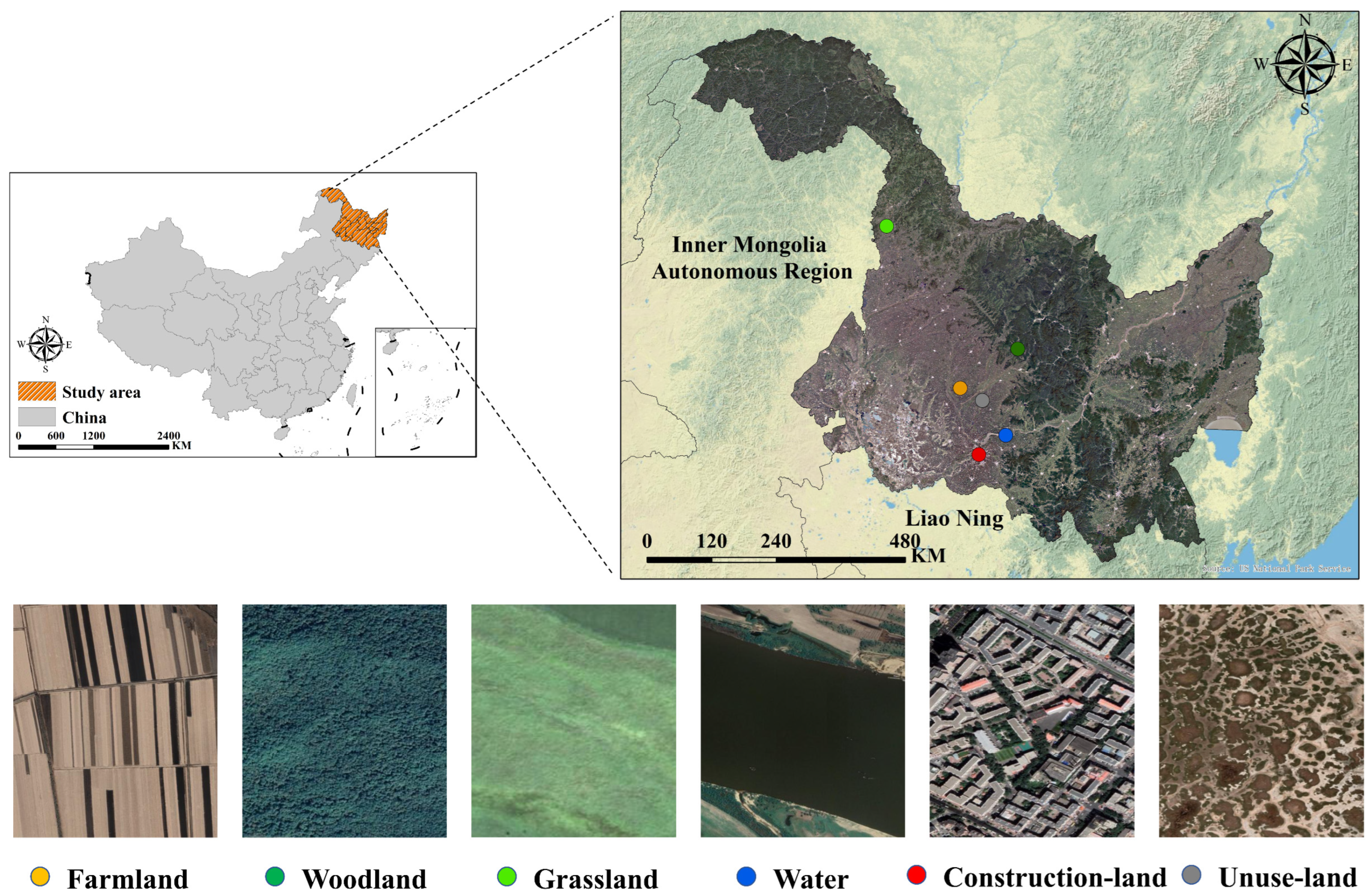
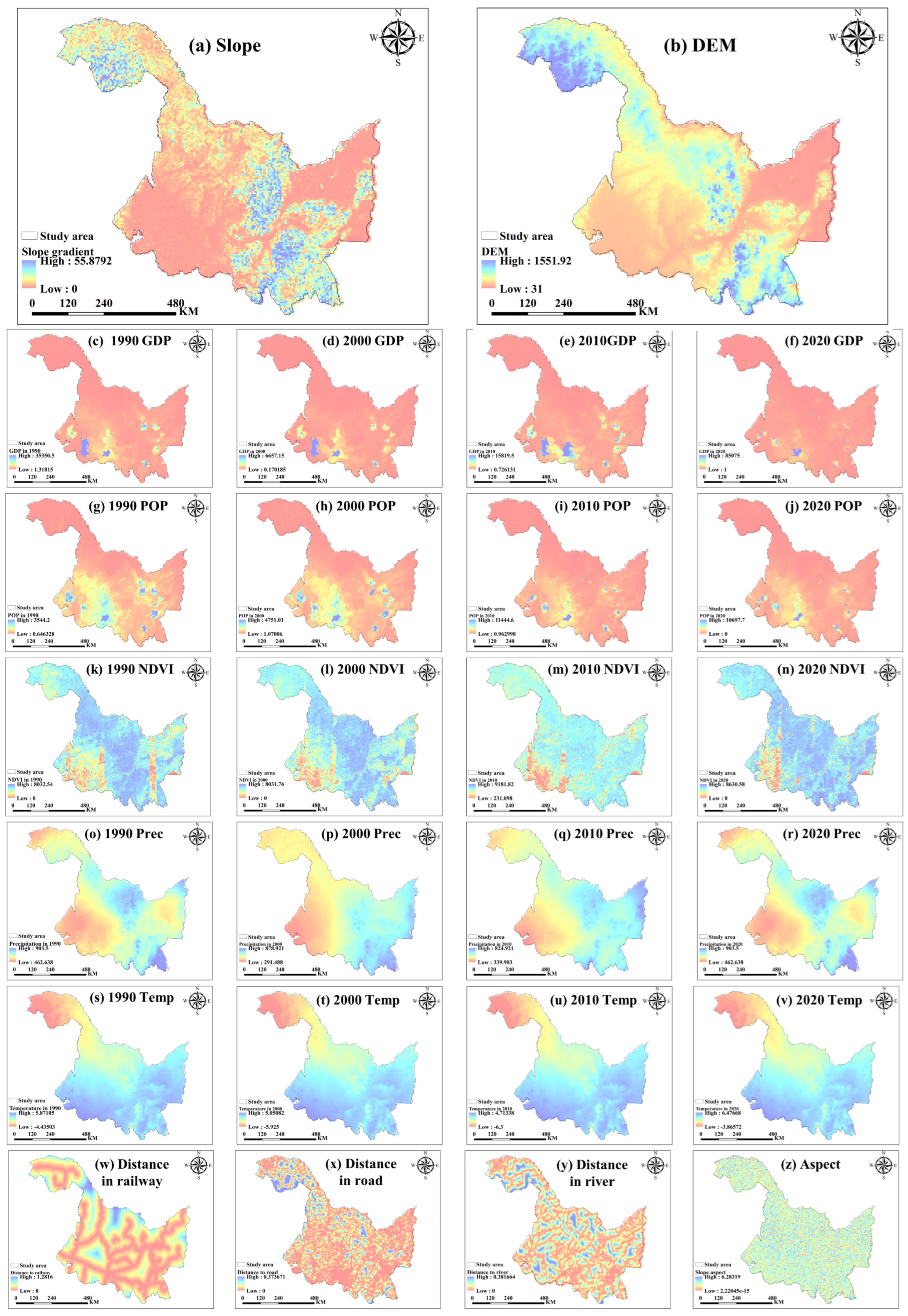
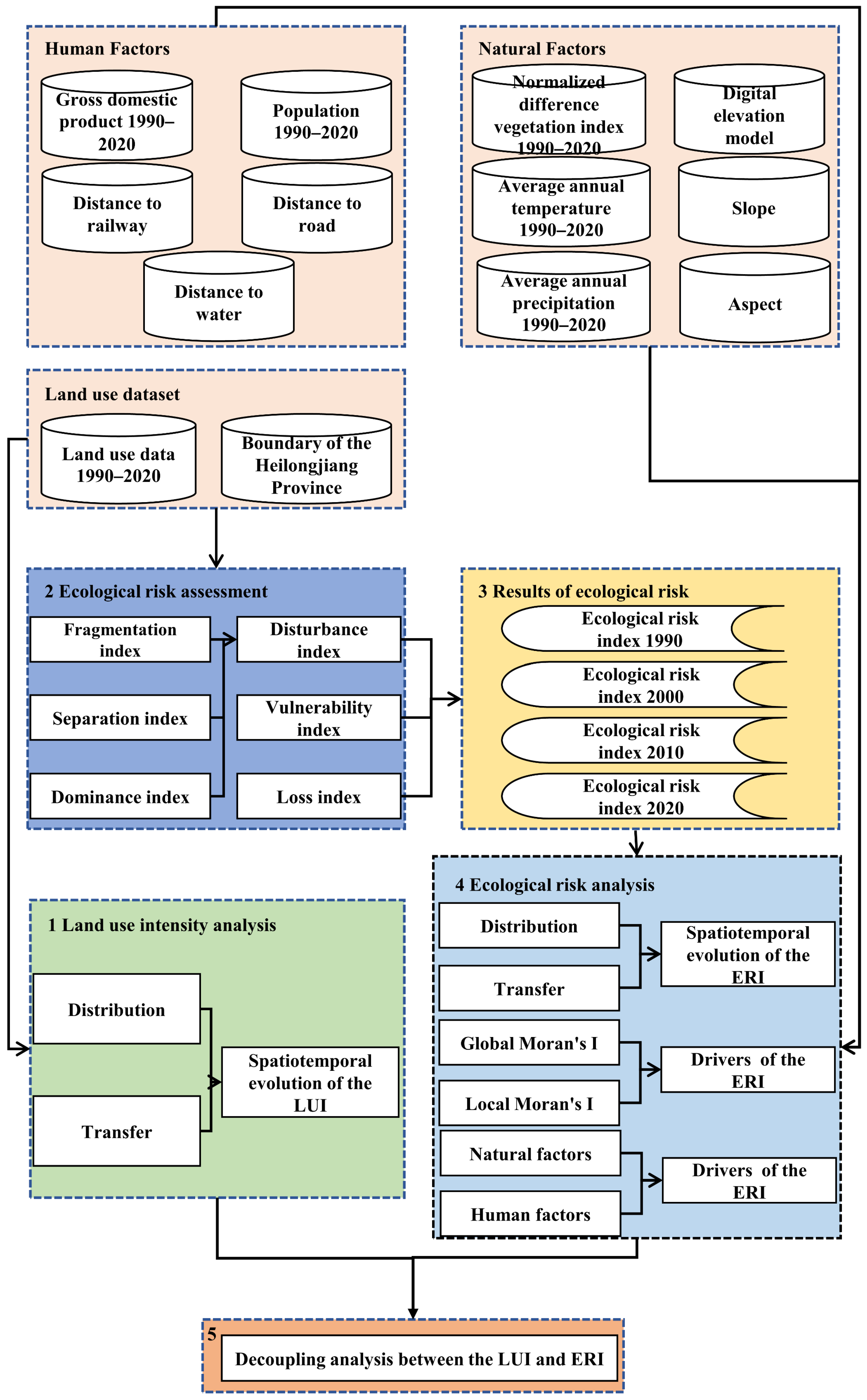
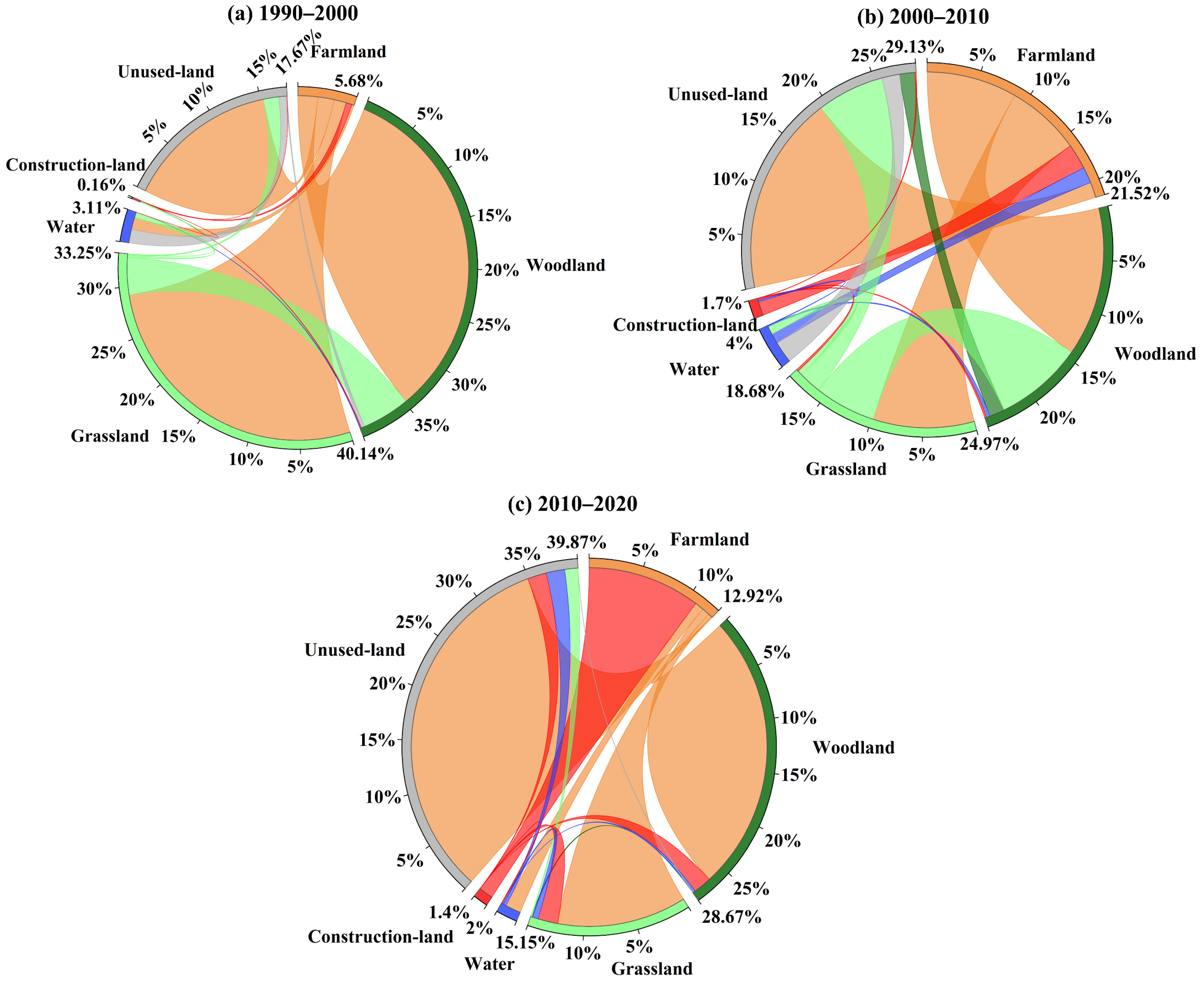
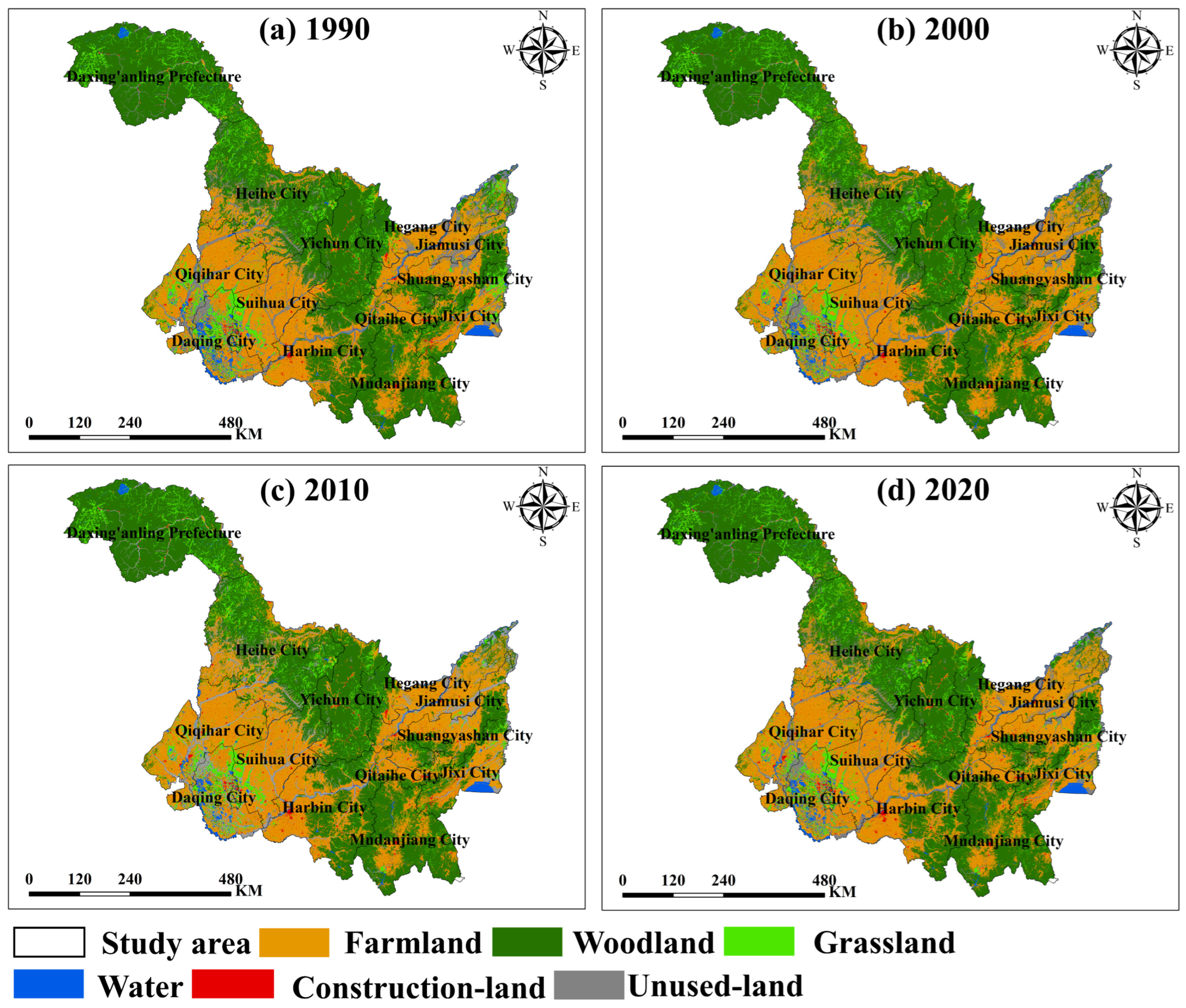
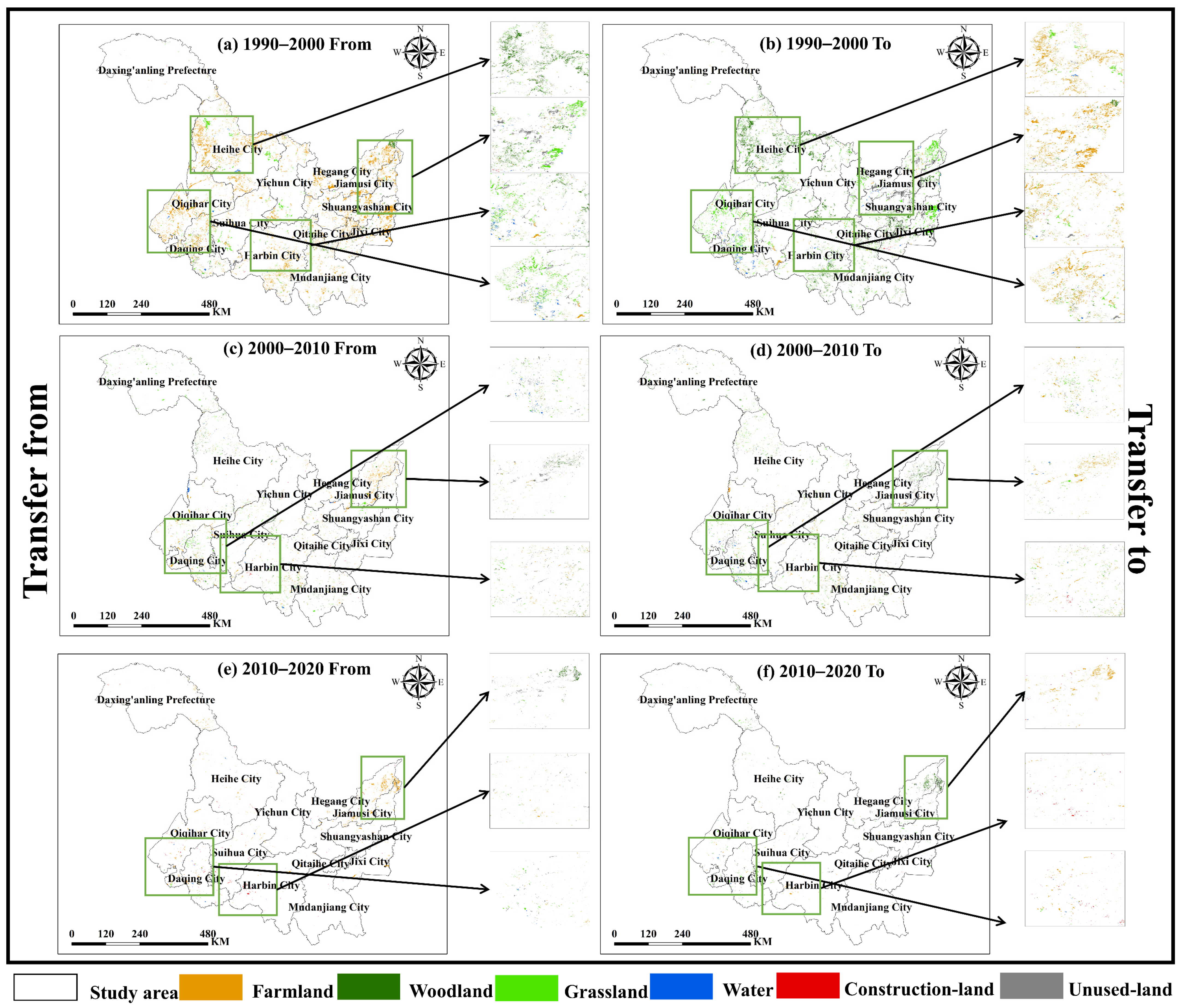
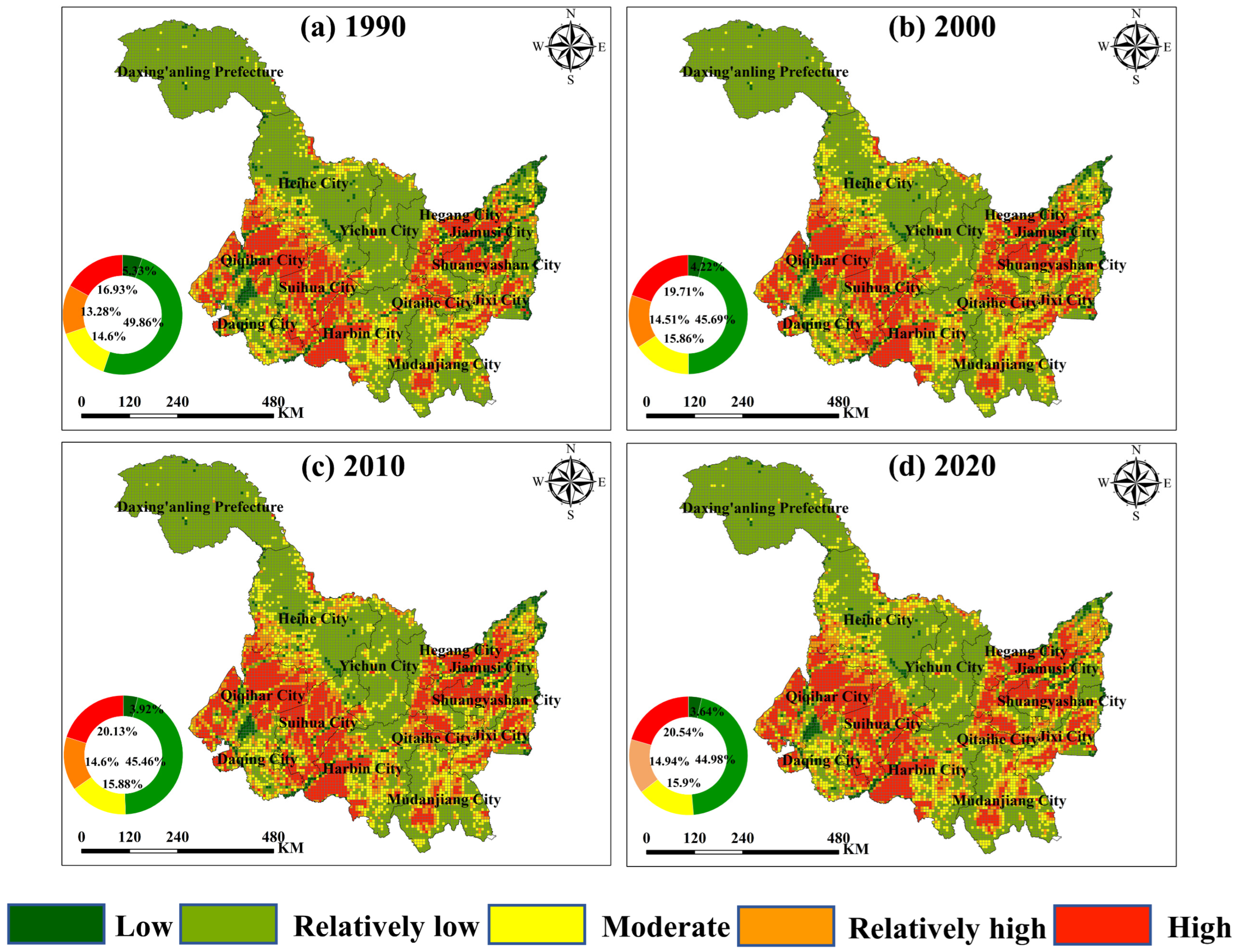
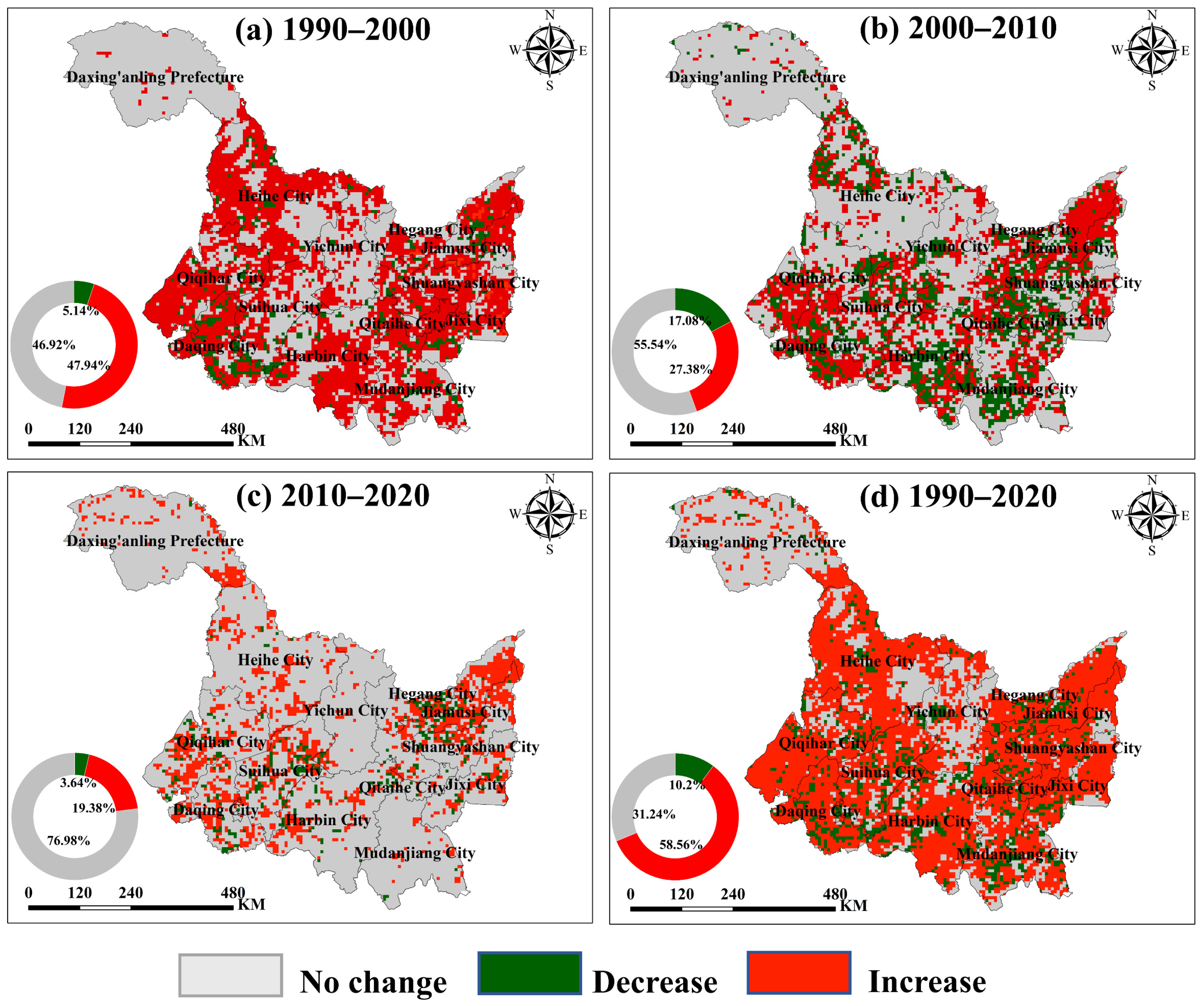
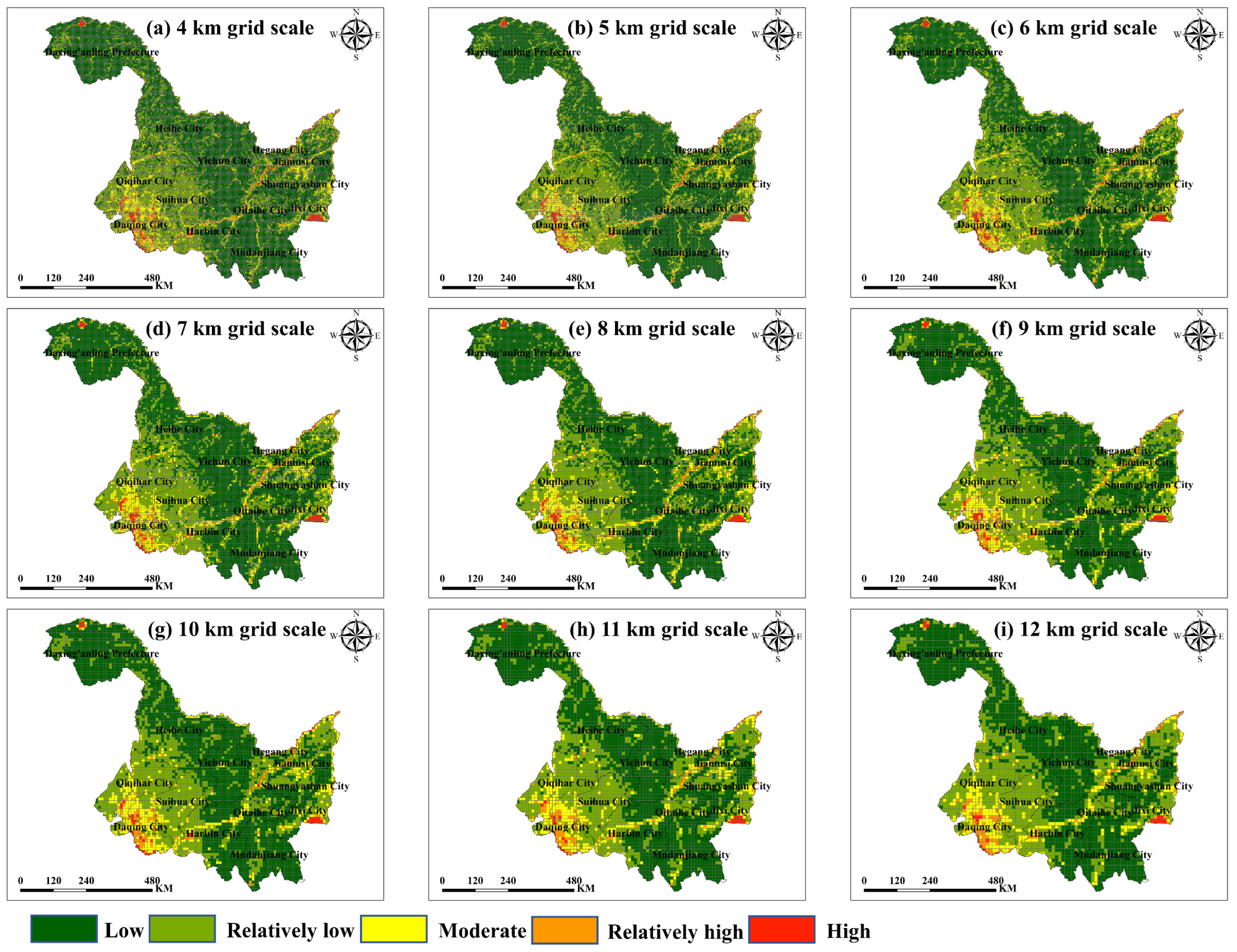
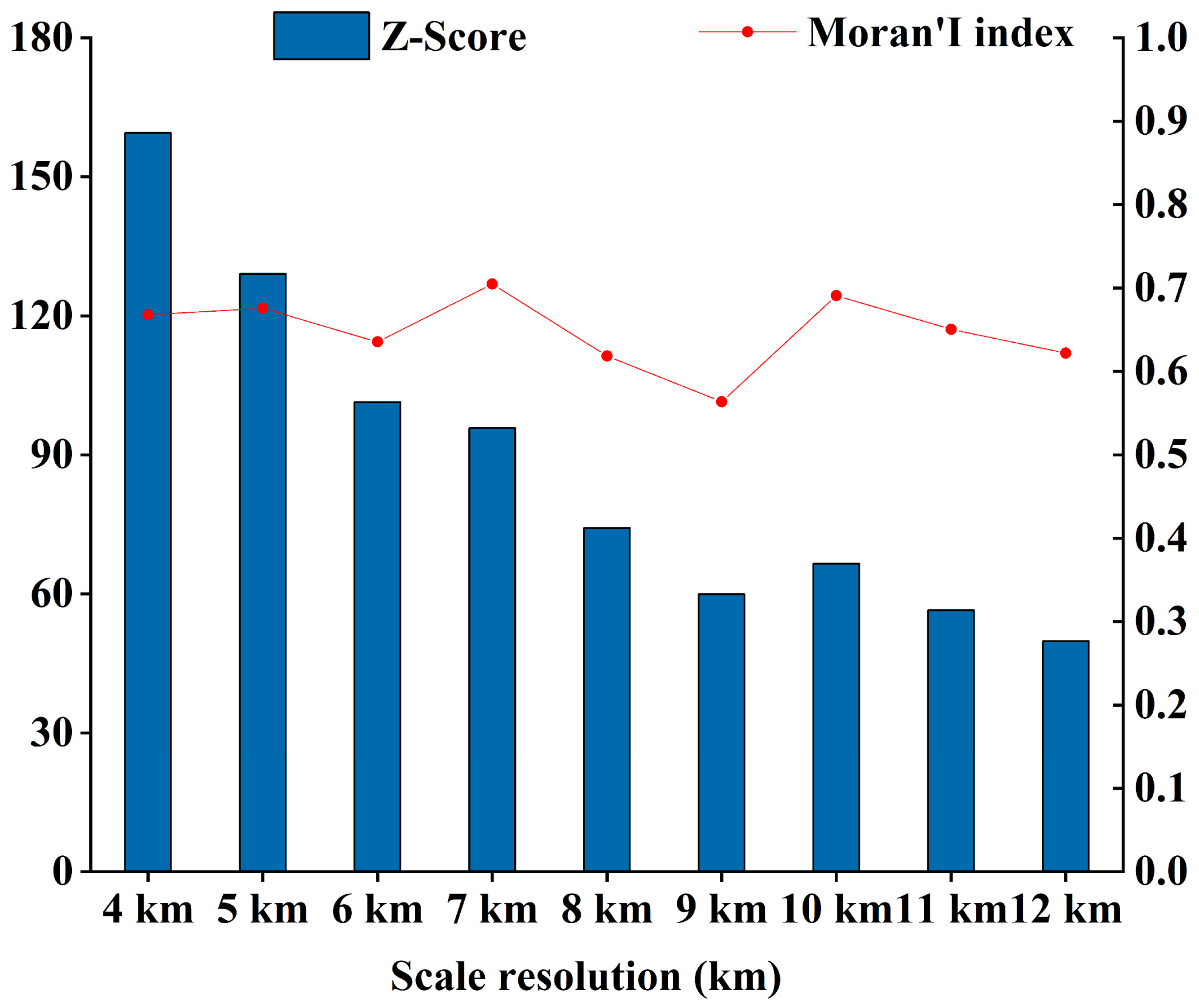
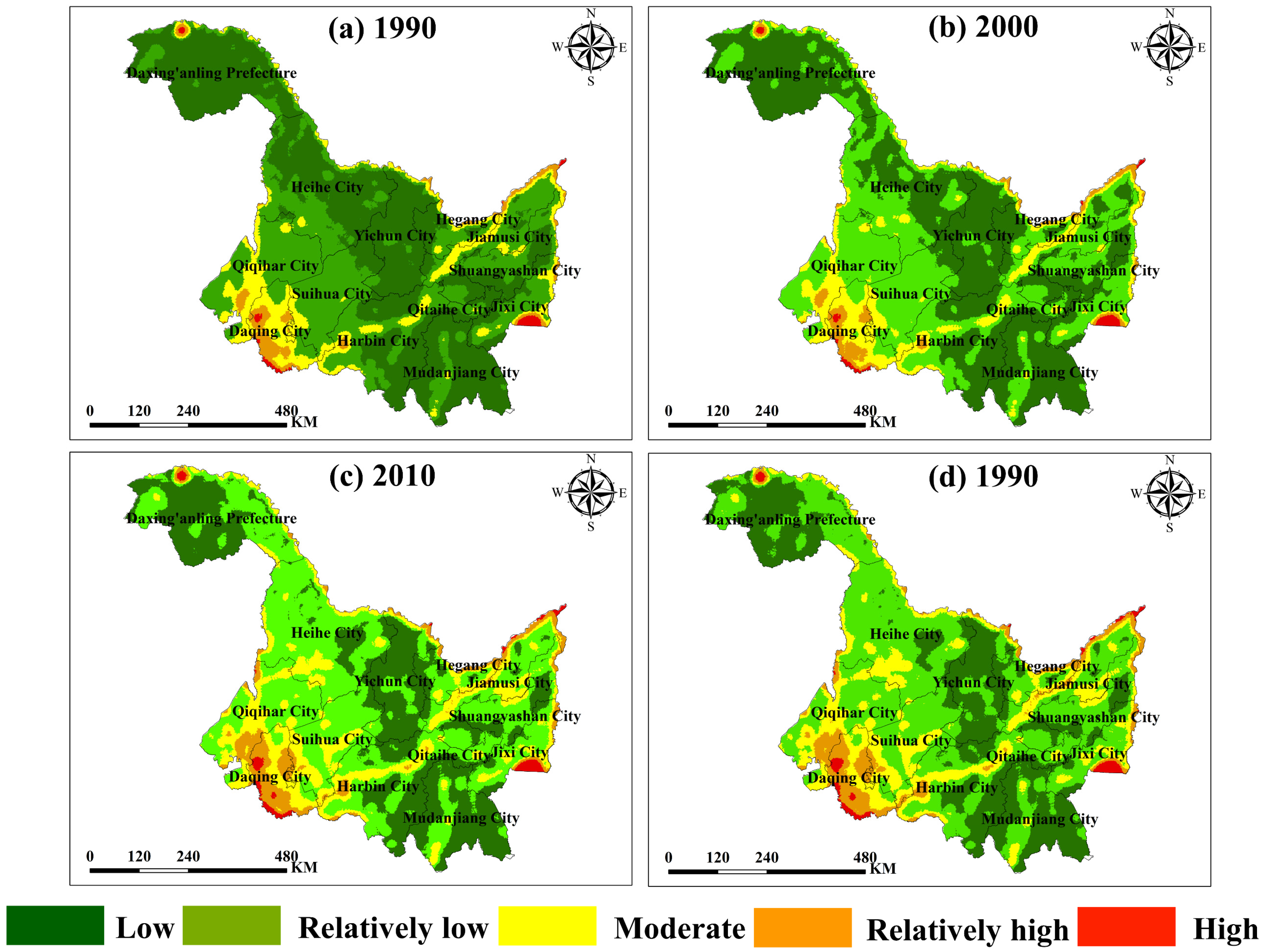
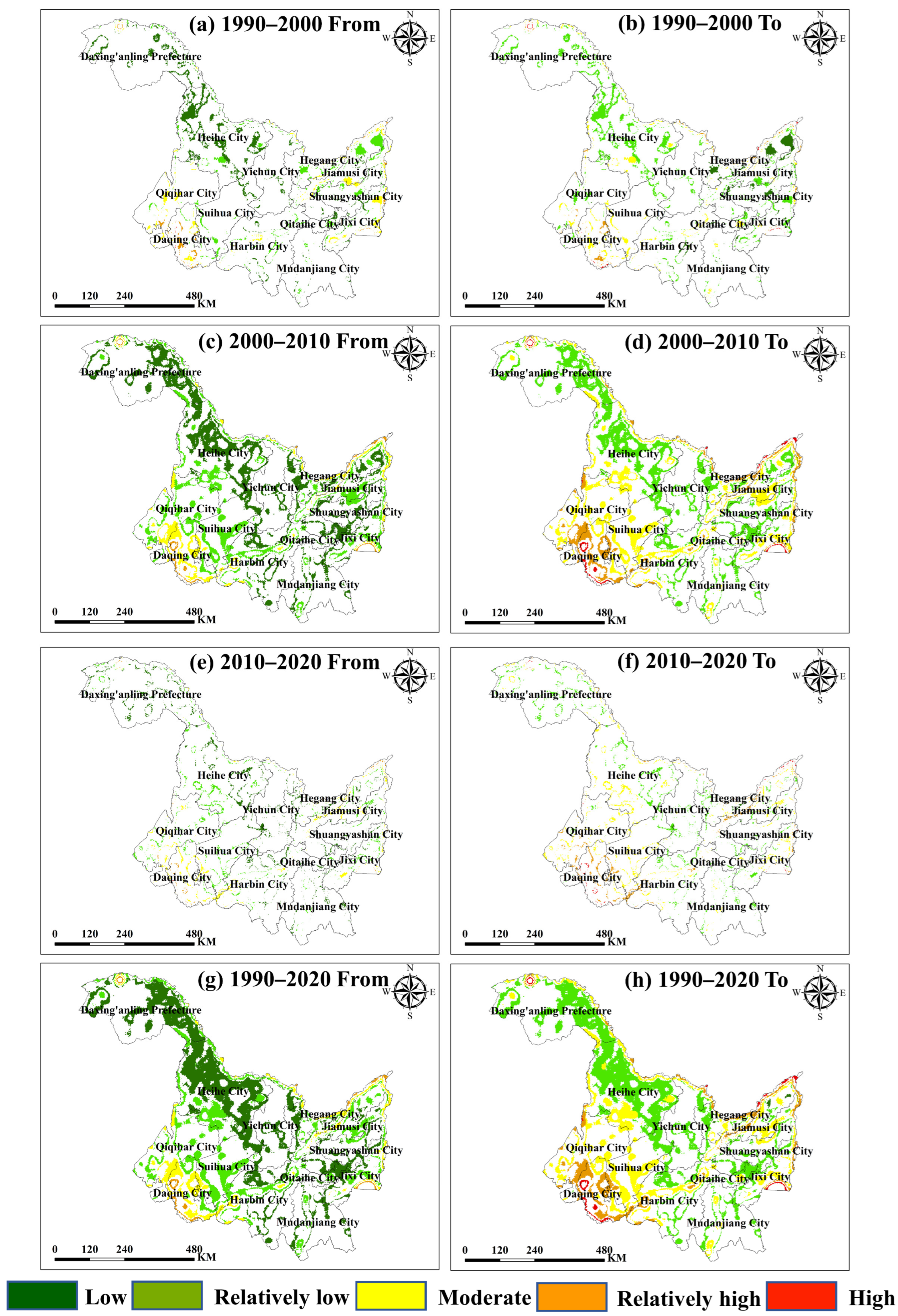
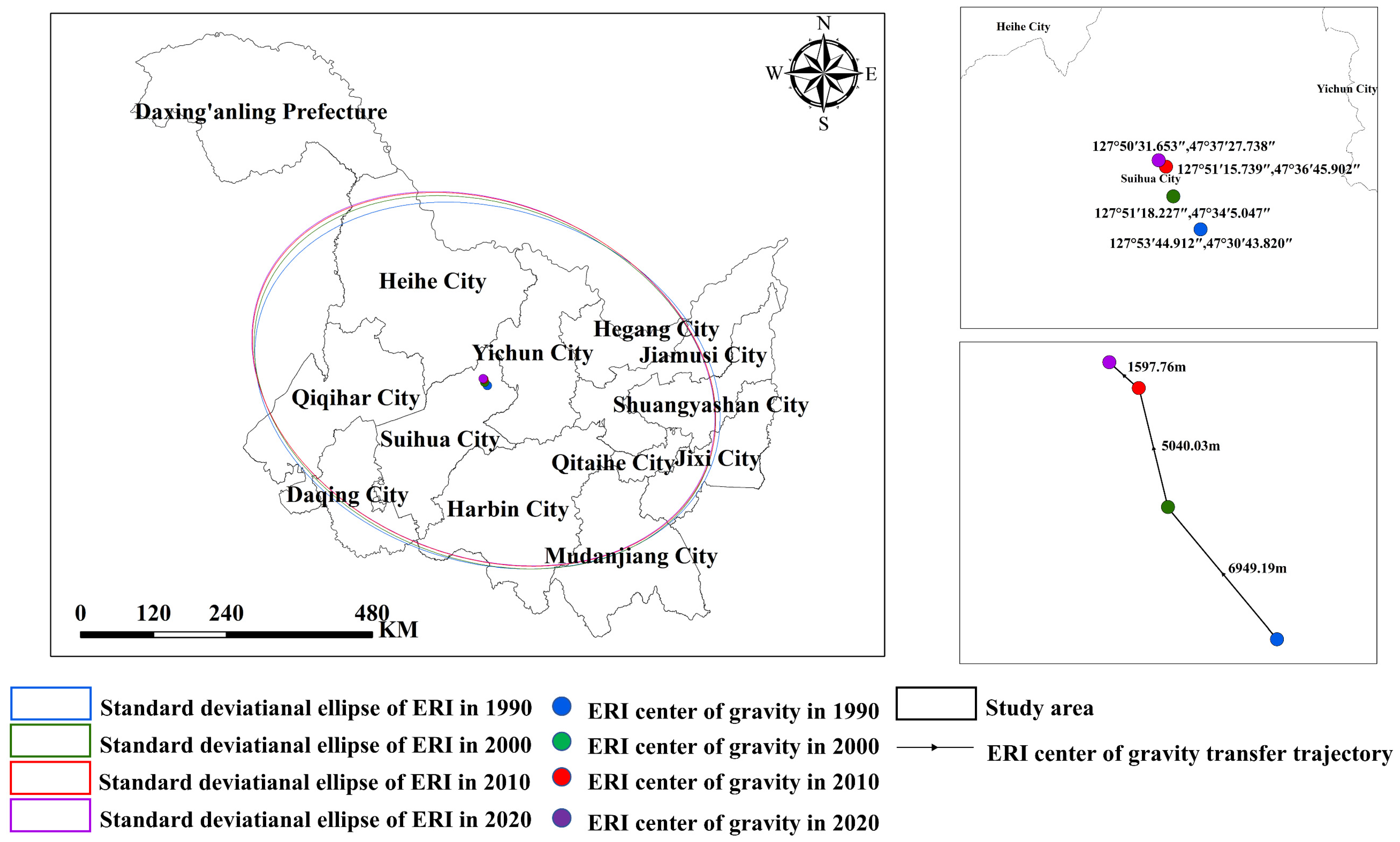
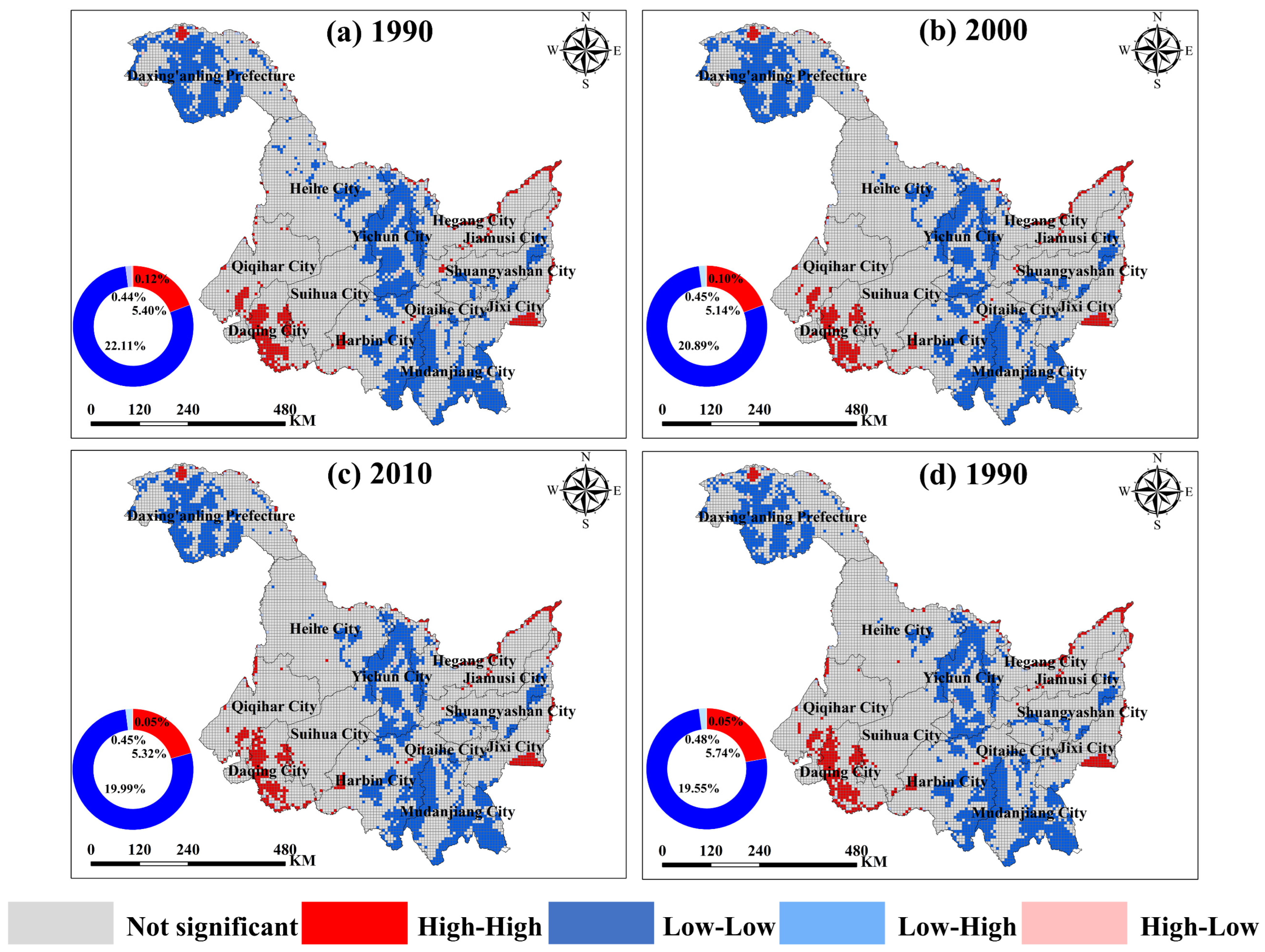

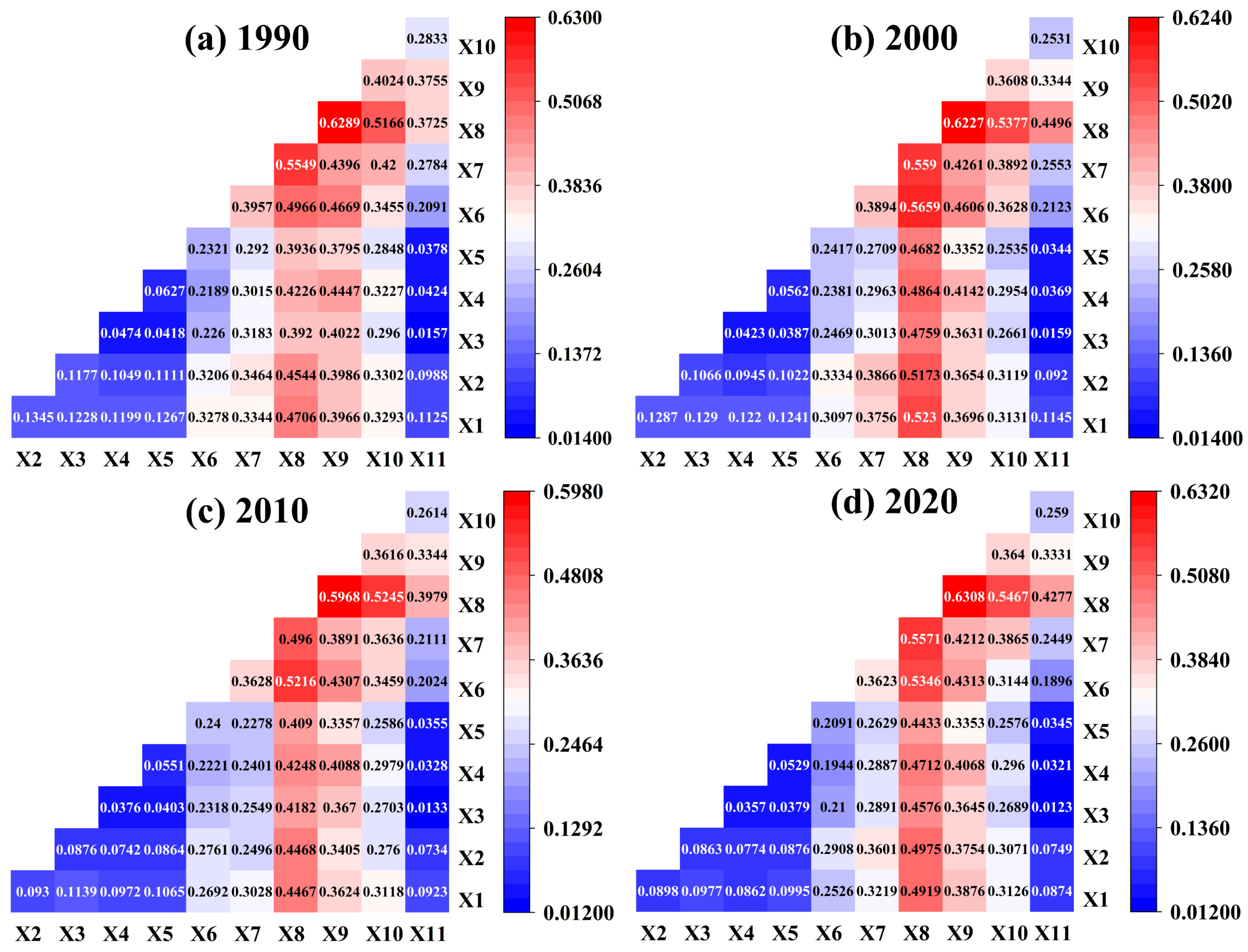
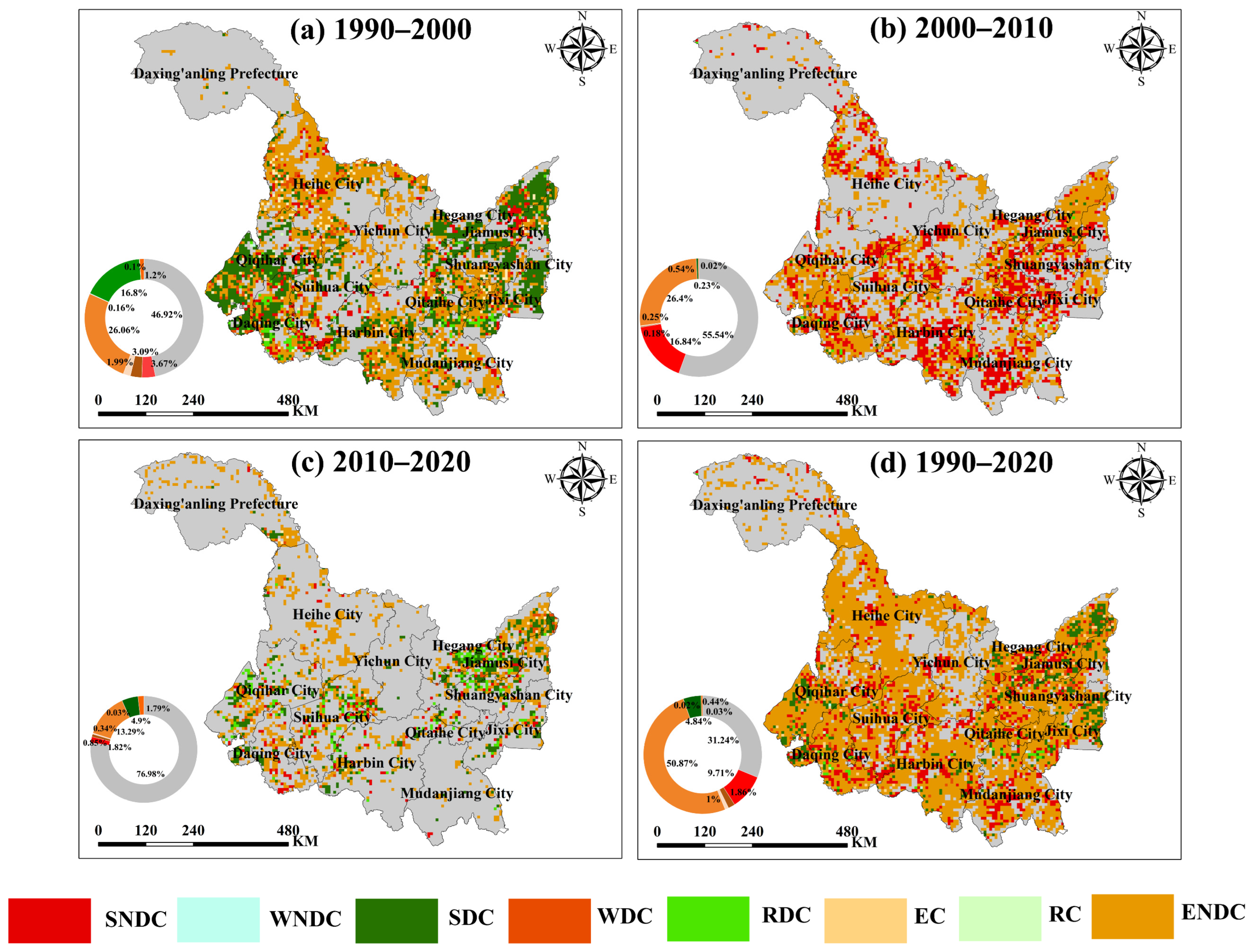
| Type | Name | Content | Resolution | Source | Year |
|---|---|---|---|---|---|
| Land use cover data | National Land-use/Cover Database of China | Farmland, woodland, grassland, water, construction land, unused land | 30 m | RESDC (https://www.resdc.cn/) (accessed on 1 July 2024) | 1990/2000/2010/2020 |
| Geographic Big Data | GDP Distribution | Total GDP within 1 km2 | 1 km | RESDC (https://www.resdc.cn/) (accessed on 1 July 2024) | 1995/2000/2010/2020 |
| Population Distribution | Average environmental population value | 1 km | RESDC (https://www.resdc.cn/) (accessed on 1 July 2024) | 1990/2000/2010/2020 | |
| Distance to Railway | / | 1 km | Open Street (https://www.openstreetmap.org/) (accessed on 1 July 2024) | / | |
| Distance to Road | / | 1 km | Open Street (https://www.openstreetmap.org/) (accessed on 1 July 2024) | / | |
| Distance to River | / | 1 km | Open Street (https://www.openstreetmap.org/) (accessed on 1 July 2024) | / | |
| Vegetation elements | Normalized Difference Vegetation Index (NDVI) | Annual NDVI maximum dataset | 30 m | Google Earth Engine (https://earthengine.google.com/) (accessed on 2 July 2024) | 1990/2000/2010/2020 |
| Meteorological elements | Precipitation | Annual total precipitation | 1 km | Google Earth Engine (https://earthengine.google.com/) (accessed on 2 July 2024) | 1990/2000/2010/2020 |
| Temperature | Annual average temperature | 1 km | Google Earth Engine (https://earthengine.google.com/) (accessed on 2 July 2024) | 1990/2000/2010/2020 | |
| Terrain elements | Topography | Digital elevation model | 1 km | Google Earth Engine (https://earthengine.google.com/) (accessed on 2 July 2024) | / |
| Slope Gradient | / | 1 km | / | / | |
| Slope Aspect | / | 1 km | / | / |
| Interaction Type | Judgment Basis |
|---|---|
| Non-linear weakening | |
| Single-factor non-linear attenuation | |
| Two-factor interaction enhancement | |
| Non-linear enhancement | |
| Mutual independence |
| Decoupling Type | Decisive Interval | Interpretation |
|---|---|---|
| Expansive negative decoupling (ENDC) | ERI increases with LUI, and its growth rate is greater than that of LUI. | |
| Expansive coupling (EC) | ERI increases with LUI at the same rate | |
| Weak decoupling (WDC) | ERI and LUI increase simultaneously, but the growth rate of ERI is lower than that of LUI | |
| Strong decoupling (SDC) | ERI decreases with increasing LUI | |
| Recessive decoupling (RDC) | ERI and LUI decreased simultaneously, but the reduction in ERI was greater than that in LUI | |
| Recessive coupling (RC) | ERI decreases with LUI at the same rate | |
| Weak negative decoupling (WNDC) | ERI and LUI are reduced at the same time, but the reduction in ERI is smaller | |
| Strong negative decoupling (SNDC) | ERI increases as LUI decreases |
| Land Use Type | 1990 | 2000 | 2010 | 2020 | ||||
|---|---|---|---|---|---|---|---|---|
| Area (km2) | Proportion (%) | Area (km2) | Proportion (%) | Area (km2) | Proportion (%) | Area (km2) | Proportion (%) | |
| Farmland | 141,709 | 31.31 | 159,765 | 35.30 | 161,432 | 35.67 | 163,353 | 36.10 |
| Woodland | 212,118 | 46.87 | 203,841 | 45.04 | 203,260 | 44.91 | 202,425 | 44.73 |
| Grassland | 38,568 | 8.52 | 32,533 | 7.19 | 32,838 | 7.26 | 32,437 | 7.17 |
| Water | 9961 | 2.20 | 9510 | 2.10 | 9526 | 2.10 | 9569 | 2.11 |
| Construction land | 8842 | 1.95 | 8976 | 1.98 | 9066 | 2.00 | 9517 | 2.10 |
| Unused land | 41,360 | 9.14 | 37,933 | 8.38 | 36,437 | 8.05 | 35,257 | 7.79 |
| Risk Type | 1990 | 2000 | 2010 | 2020 | ||||
|---|---|---|---|---|---|---|---|---|
| Area (km2) | Proportion (%) | Area (km2) | Proportion (%) | Area (km2) | Proportion (%) | Area (km2) | Proportion (%) | |
| Low | 213,816 | 47.42 | 200,931 | 44.57 | 135,919 | 30.15 | 126,511 | 28.06 |
| Relatively low | 171,096 | 37.95 | 183,686 | 40.74 | 208,396 | 46.22 | 210,563 | 46.70 |
| Moderate | 50,502 | 11.20 | 50,574 | 11.22 | 77,101 | 17.10 | 80,926 | 17.95 |
| Relatively high | 12,826 | 2.84 | 12,820 | 2.84 | 24,486 | 5.43 | 27,502 | 6.10 |
| High | 2614 | 0.58 | 2843 | 0.64 | 4952 | 1.10 | 5352 | 1.19 |
Disclaimer/Publisher’s Note: The statements, opinions and data contained in all publications are solely those of the individual author(s) and contributor(s) and not of MDPI and/or the editor(s). MDPI and/or the editor(s) disclaim responsibility for any injury to people or property resulting from any ideas, methods, instructions or products referred to in the content. |
© 2025 by the authors. Licensee MDPI, Basel, Switzerland. This article is an open access article distributed under the terms and conditions of the Creative Commons Attribution (CC BY) license (https://creativecommons.org/licenses/by/4.0/).
Share and Cite
Wu, B.; Zheng, F.; Fu, Y.; Peng, S.; Yang, X.; Wang, L.; Flanagan, D.C.; Zhang, J.; Li, Z. Decoupling Land Use Intensity and Ecological Risk: Insights from Heilongjiang Province of the Chinese Mollisol Region. Remote Sens. 2025, 17, 2243. https://doi.org/10.3390/rs17132243
Wu B, Zheng F, Fu Y, Peng S, Yang X, Wang L, Flanagan DC, Zhang J, Li Z. Decoupling Land Use Intensity and Ecological Risk: Insights from Heilongjiang Province of the Chinese Mollisol Region. Remote Sensing. 2025; 17(13):2243. https://doi.org/10.3390/rs17132243
Chicago/Turabian StyleWu, Binglong, Fenli Zheng, Yuchen Fu, Shouzhang Peng, Xihua Yang, Lun Wang, Dennis C. Flanagan, Jiaqiong Zhang, and Zhi Li. 2025. "Decoupling Land Use Intensity and Ecological Risk: Insights from Heilongjiang Province of the Chinese Mollisol Region" Remote Sensing 17, no. 13: 2243. https://doi.org/10.3390/rs17132243
APA StyleWu, B., Zheng, F., Fu, Y., Peng, S., Yang, X., Wang, L., Flanagan, D. C., Zhang, J., & Li, Z. (2025). Decoupling Land Use Intensity and Ecological Risk: Insights from Heilongjiang Province of the Chinese Mollisol Region. Remote Sensing, 17(13), 2243. https://doi.org/10.3390/rs17132243







